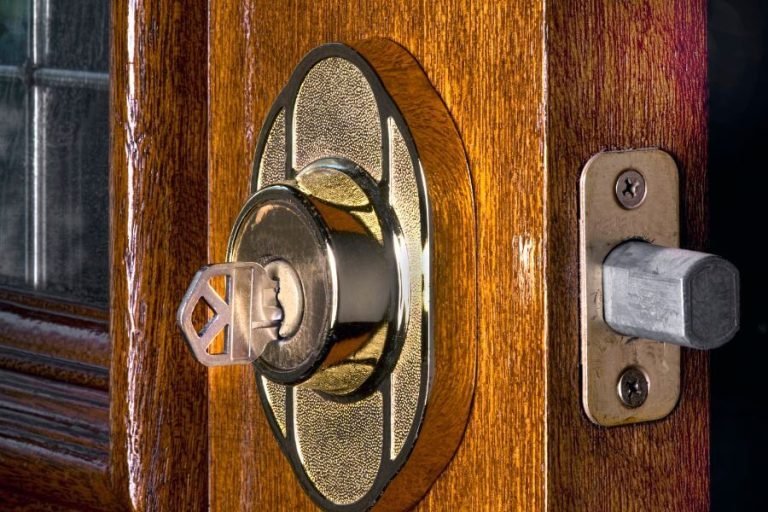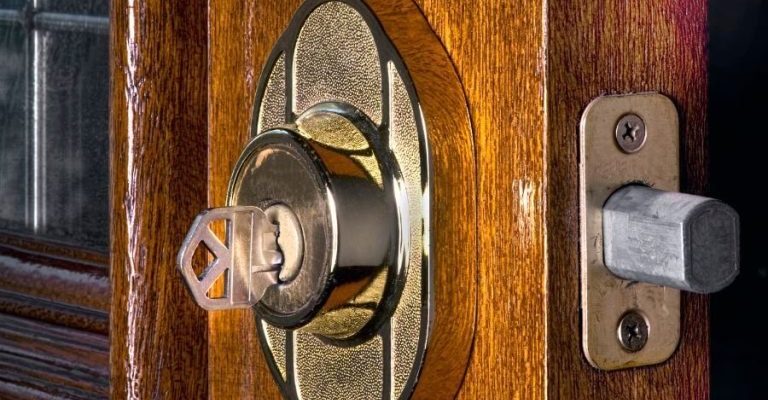
So, what’s going on? Why does the *part you twist to lock or unlock* suddenly feel like it’s dancing in its seat? You might be thinking of code, batteries, or remote pairing if you had smart locks, but even classic keyed deadbolts can have issues that rattle your confidence (and your door). Let’s break down what causes deadbolt thumbturn wobble, how to spot a real problem, and what you can do about it—without turning into a locksmith overnight.
How Deadbolt Thumbturns Are Supposed to Work
Before you can figure out what’s wrong, it helps to know what a thumbturn is *meant* to do. The thumbturn is that little lever or knob on the inside of your deadbolt—grab it, twist, and the lock should smoothly slide open or shut. Inside, a few small but sturdy parts come together, almost like gears in a clock—except you’re the “remote” here, powering it by hand.
Most modern deadbolts, like those from Schlage or Kwikset, use a metal shaft that connects the thumbturn to the locking bolt. When you rotate the thumbturn, it moves this bolt into or out of the strike plate in your doorframe. There’s usually a set screw or two that keeps the shaft secure and stops the thumbturn from twisting endlessly.
The key thing: everything should feel firm. Sure, there’s sometimes a *tiny* bit of play—no lock is perfectly tight—but you shouldn’t feel the thumbturn flopping around or shifting sideways. If you start noticing excessive movement, that’s your first sign something underneath isn’t doing its job.
What Causes Excessive Wobble in a Deadbolt Thumbturn?
Here’s the thing—there’s a HUGE difference between a gentle wiggle and a thumbturn that moves like it’s barely attached. If yours feels like it’s about to fall out, here are the most common culprits:
- Loose mounting screws: The screws that hold your deadbolt assembly together can loosen over time, especially if doors are slammed or the lock is used a lot. This can let the thumbturn shaft shift out of place.
- Stripped or worn parts: If the metal shaft or internal parts are stripped, they won’t grip each other properly, causing wobble and making it hard to sync up the bolt movement.
- Misaligned installation: Sometimes, the deadbolt isn’t installed squarely. This can put extra pressure on the thumbturn and make it wobbly.
- Cheap or aging hardware: Lower-quality locks, or those that have seen years of use, can develop slack in their moving parts. Springs can weaken, and plastic parts can wear out.
Let me explain with a quick example. I once helped a friend with a decades-old Kwikset deadbolt. The thumbturn would spin halfway around before the bolt even budged. The culprit? A set screw had fallen out, and nobody noticed until the wobble became impossible to ignore.
How to Check If Your Thumbturn Wobble Is a Real Problem
Honestly, a *tiny* amount of wiggle is normal. Metal expands and contracts, doors settle, and daily use can loosen things up ever so slightly. But when does it cross the line?
Here’s how to test:
- Grab the thumbturn and gently move it side to side.
- If it moves more than a couple millimeters or feels like it’s coming off, that’s excessive.
- Try locking and unlocking. If the bolt doesn’t move smoothly or you feel resistance, that’s a red flag.
Pay attention to any rattling sounds or visible gaps between the thumbturn and the lock face, too. And if your deadbolt is smart (using a Yale, August, or similar WiFi-connected lock), *wobble might prevent it from syncing properly or cause code entry problems*.
If you feel like your thumbturn might come off in your hand, don’t ignore it. That’s not just an annoyance—it’s a real security risk.
Step-by-Step: How to Fix a Wobbly Deadbolt Thumbturn
You don’t have to be a handyman (or handywoman) to tighten up a wobbly thumbturn. Here’s a simple, beginner-friendly way to troubleshoot and fix it:
What you’ll need:
- Phillips or flathead screwdriver (depends on your lock)
- Allen wrench (sometimes needed for set screws)
- Optional: Replacement screws or parts if anything looks stripped
What to do:
- Unscrew the interior portion of the deadbolt—the side with the thumbturn. Set the screws aside in a safe spot.
- Carefully pull off the cover and inspect the inside. Look at the shaft and any small set screws holding it in place. If something’s fallen out, you might find it rattling around inside.
- Tighten any obvious loose screws. If anything is stripped or missing, consider replacing it—most hardware stores sell universal deadbolt parts.
- Reassemble the deadbolt. Make sure everything lines up and feels snug—don’t overtighten or you could strip the threads.
- Test the thumbturn again. Does it move smoothly and feel secure? If yes, job’s done. If not, double-check for worn parts or misalignment.
If you have a smart deadbolt, remember to check the pairing and battery status after reassembly. Sometimes, taking things apart can disrupt the internal sync between the hardware and your remote app.
When Should You Replace the Deadbolt Instead?
Sometimes, you can’t fix excessive thumbturn wobble with just a screwdriver. Here’s where replacement makes sense:
- Worn or stripped parts: If the shaft or bolt is worn down or the internal mechanism is damaged, you’ll keep having the same issue. Replacement is safer.
- Repeated repairs: If you keep tightening screws and it never stays fixed, the entire lock might be on its last legs.
- Upgrading for security: Older locks, or deadbolts with wobble issues, are easier for burglars to bypass. Upgrading to a modern, high-quality deadbolt (smart or traditional) is a smart move.
You might be wondering if you can just replace *only* the thumbturn part, but most brands—like Kwikset and Schlage—design their deadbolts as full assemblies. Swapping just the inside piece isn’t always possible, unless you’re using a universal deadbolt set.
If you’re replacing your lock, take time to code and pair your new smart deadbolt properly, or double-check the installation steps if you’re going with a mechanical version. It’s worth doing it right for peace of mind.
Comparing Universal vs Brand-Specific Deadbolt Repairs
Some people are tempted to buy “universal” repair kits for deadbolts when their thumbturn starts to wobble. These kits claim to fit any lock, but is that your best bet?
Brand-specific parts—like those made for Schlage, Yale, or Kwikset—are usually the best fit. The design, threading, and sizing will match exactly, making repairs smoother and the finished lock more secure.
Universal kits can work in a pinch, especially if you have an older or off-brand lock. But you might find that the fit isn’t perfect, the screws are a hair too long, or the thumbturn feels “off” even after repair.
If security matters to you (and let’s be honest, it does), sticking with brand-name or professional-grade parts is the safest play.
And here’s a tip: if you’re ever unsure about compatibility, take the worn part with you to the hardware store or ask a locksmith for advice. Most pros are happy to help, and it could save you a second trip.
Is a Wobbly Deadbolt Thumbturn a Security Risk?
It’s easy to ignore a loose thumbturn until it gets really bad, but honestly, it’s not just an annoyance. A wobbling lock is a vulnerable lock. Burglars look for weak spots, and a thumbturn that shifts around could mean the whole mechanism is loose—making it easier to force open with a little effort.
Even if you use a smart deadbolt that needs a code or remote pairing, the mechanical side matters. If the physical connection is weak, the electronics won’t save you. Plus, any lock that feels off can confuse guests or workers who rely on your code to get in (or cause *you* stress fumbling with a remote late at night).
Bottom line: Treat any excessive wobble as a sign to act. Tighten it up, replace the necessary parts, and make sure you’re protected.
Tips for Preventing Deadbolt Thumbturn Issues in the Future
You’ve fixed your wobbly thumbturn—nice! But how can you avoid this headache down the road? Here’s what helps:
- Regularly check and tighten screws: Give your locks a quick inspection every few months. It only takes a minute to tighten up any loose parts.
- Avoid slamming doors: The shock from slamming can slowly loosen mountings, especially on older hardware.
- Use locks gently: If you ever feel resistance when turning the thumbturn, don’t force it. Check for obstructions or misalignment.
- Upgrade when necessary: When your lock starts feeling loose or unreliable, it’s often worth investing in a new one instead of endless patchwork fixes.
- For smart locks: Keep an eye on battery levels and test your code/remote features regularly. Don’t let electronic troubles mask underlying hardware issues.
A little routine care goes a long way—think of it as syncing up your home’s security, so you’re not troubleshooting a major failure when it matters most.
Wrapping Up: Don’t Ignore a Wobbly Thumbturn
A deadbolt thumbturn shouldn’t wobble like a loose doorknob. If yours does, it’s more than just a nuisance—it’s a warning that something’s out of sync, ready to fail, or putting your security at risk. The good news is, most fixes are within reach: inspect for loose screws, check for worn or missing parts, and don’t be afraid to upgrade your lock if needed.
Trust your instincts: if your deadbolt feels off, it probably is. Whether it’s a classic keyed lock or a high-tech smart model with code and remote features, a secure, snug thumbturn is the sign of a healthy lock—and a safer home. Every now and then, take a moment to check that everything’s tight and working as it should. Your peace of mind is worth it.
